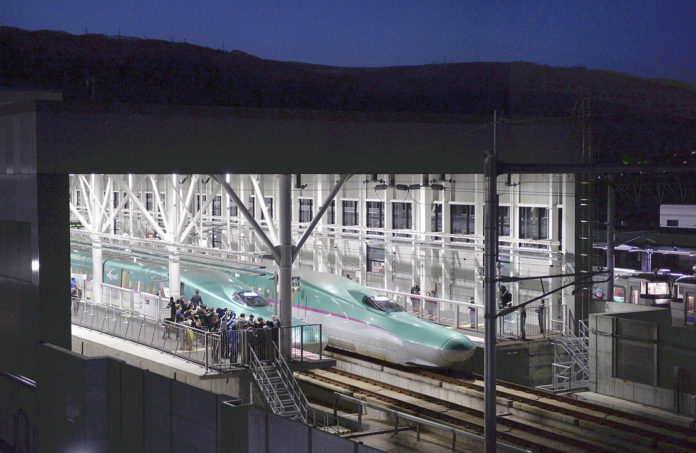With the opening of the Hokkaido Shinkansen line on March 26, the Japanese islands of Hokkaido, Honshu and Kyushu have finally been linked by bullet train – 43 years after plans for a national high-speed rail network were first laid out in 1973. Although regions across the country have high hopes that construction of Shinkansen lines will be an economic boon, the plans are facing problems, including profitability and securing funds.
After the first Hokkaido Shinkansen train, Hayabusa No. 10, departed Shin-Hakodate-Hokuto Station at 6:35 a.m. on the inaugural day, Hokkaido Gov. Harumi Takahashi said: “The opening of the Shinkansen marks the start of a new challenge. I hope we can vitalize Hokkaido by attracting as many passengers as possible.”
Hotels in Hakodate were nearly full on March 26 and 27. In what is normally a quiet period before the long Golden Week holiday period that starts in late April, reservations were 30 percent above average for the month. At the Hakodate Morning Market near Hakodate Station, a seafood shop selling delicacies such as crab and shishamo smelt enjoyed an about 1.5-fold sales increase compared to the previous weekend.
Construction of a large-scale shopping facility in front of Hakodate Station is wrapping up before its planned summer opening. Car rental companies have opened branches in front of Shin-Hakodate-Hokuto Station, and next February a new commercial complex whose tenants include a hotel and restaurants will open.
The Hokkaido Shinkansen line appears to have made a good start, but the 24 percent reservation rate for the route between Shin-Hakodate-Hokuto and Shin-Aomori for the first nine days reveals a dimmer outlook.
The combined basic fare and express ticket between Tokyo and Shin-Hakodate-Hokuto is less expensive than the fares of major airlines between Haneda and Hakodate airports, but the difference, when discounted tickets are taken into account, is minor.
The fastest train between Tokyo and Shin-Hakodate-Hokuto takes four hours and two minutes – just missing the four-hour barrier at which high-speed trains are considered competitive against airplanes.
Although All Nippon Airways (ANA) discounted its fares in response to the opening of the Hokuriku Shinkansen line extension to Kanazawa, company President Osamu Shinobe was calm about the Hokkaido Shinkansen line, declaring that ANA is “not taking any special measures” in response.
According to Hokkaido Railway Co. (JR Hokkaido), even if the new line attracts a 30 percent share of the travel market for passengers to Tokyo, the increased expense of maintaining the Seikan Tunnel that connects Hokkaido and Honshu is expected to result in an average loss of 4.8 billion yen (about $42,974,208) each year from fiscal 2016 to 2018.
Losses have become standard for JR Hokkaido – as demonstrated in its consolidated financial report for fiscal 2015 ending in March, in which a 42 billion yen operating shortfall is expected – and the firm has been maintaining itself with support from the central government. It is essential for the company to lead the opening to an improvement in performance.
Thorough safety measures are required for the Hokkaido Shinkansen line, which not only runs through a cold area but also shares an 82-kilometer (about 50 miles) stretch of track – of which 54 kilometers are in the Seikan Tunnel – with freight trains. For the time being, high-speed trains will be limited to 140 kph (about 86 mph) along the shared segments to prevent wind pressure from impacting passing freight trains.
It is also easy for snow and ice to accumulate at the point where the tracks branch off. That portion has been covered like a tunnel and outfitted with electric heaters to melt the snow and also compressed air equipment to blow it away. A JR Hokkaido official said they “must engage in safety maintenance by increasing staff numbers in limited periods.”
Inside the tunnel, unused undersea train stations are equipped with cable cars for evacuation to the surface. The capacity of these will be increased from the current 15 to 38 in August.






